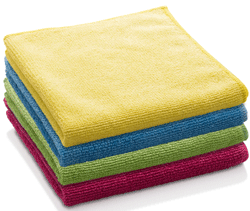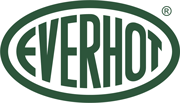Cleaning Your Everhot
Everhots are very easy to keep clean; there will always be a few splatters to keep on top of - it is in daily use of course - but it's never a big task if you follow the basics.
The Basics
Always follow the principle of wiping up spills before they become baked on.
Use a damp cotton dishcloth or e-cloth to wipe up any spills. Remember the cooker is an electrical appliance; do not use excess water when cleaning the cooking zones.
Occasionally sweep out (or use your vacuum cleaner’s hose) the base of the ovens to remove the carbonised dust (when the oven is cool enough).
It is always best to clean the cooker when it is cold.
If the cooker is hot do not use a cloth or cleaning pad / sponge made of synthetic (plastic) material - it’ll melt in contact with the hotplate or inside the oven, and be aware to keep redampening the cloth with cold water so it doesn’t scald or burn.
Do not use any abrasive products on the coloured or mirrored surfaces.
Hotplates
The hot plates are largely self-cleaning. Any liquids will evaporate without any assistance. Any spilt solids will carbonise and you can wipe them off with a damp (natural fibre) cloth. Remove any stubborn residue by brushing with a wire brush or use a ‘hob scraper’ (sharp blade in a purpose-made handle).

Wire brush (use on the cast-iron)

Hob scraper
Ovens
Leaving an oven door open [or removing it] with the cooker on allows the heat to escape and heat up the handrail – be aware of this and take adequate precautions to protect yourself and other householders.
The inner part of the ovens are largely self-cleaning. Any spills normally carbonise. (This carbonising of spills and splashes happens more quickly at higher temperatures so if you use ECO mode and/or run your ovens lower settings then the self-cleaning will happen more slowly.)
Primary (Top) Oven
This is made from 5mm thick plain steel – if you wipe with a wet cloth and leave it, a small amount of oxidisation (also known as rust!) can sometimes naturally occur. This is harmless and will slowly disappear as the oven is used, however to limit the effect don’t splash or use excess water in the oven. It (rusting) won't happen if your oven is on all the time, or is warmed up regularly each week.
Lower Oven(s)
The lower ovens are made from stainless steel so are unlikely to stain or mark. They are very easy to clean by just wiping out.
Oven Floor
The ovens have a (shiny) stainless-steel floor – this is a cover for the heating element. YOU MUST TURN OFF THE COOKER BEFORE CLEANING OR LIFTING OUT THE OVEN ELEMENT COVER which can be done in-situ or, lift it out so it can be done more easily in the sink or on a worktop.
Shelf Runners
Wipe the stainless-steel oven inserts (the channels fastened to the sides of the ovens that the shelves run in/on) regularly with a cloth to make cleaning easier.
Oven Doors
See below for info on the cooker's outer surfaces.
Top and Outer Surfaces
Brushed / Grained Stainless Steel Surfaces
These are:
- The main top of the cooker at hotplate level
- The lids
- The (loose) hotplate surround
- The hotplate lid liner [over the cast hotplate, not the induction hob lid liner]
- The oven door liners
- The lower ovens
- All oven floor / element covers and the oven ‘tunnels’ [the bit between the front plate and the actual oven itself]
Notes before you start:
Lids: it’s best to avoid the need to clean! Why not use a lid splash shield which hangs on the inside of the lid to protect it from being splashed in the first place.

Oven doors: it’s easier to clean an oven door when it’s not on the cooker: first, lay a soft cloth or towel on the worktop, then lift the door off the cooker (it’s heavy - lift vertically) and place coloured side down on the towel to leave good access to the door liner.
Three Stage Cleaning Process
(For the stainless-steel parts.)
(Least to most aggressive.)
Which to start with depends on how baked-on the splashes are. (With any of these methods always work or rub in the same direction as the graining in the finish.)
1. Try this first
Wipe with a damp e-cloth – using either water or a ‘mild detergent solution’ (clean washing up water).

2. If that doesn't work
Use the ‘green scrubber’ side of a Spontex (or similar) style washing-up pad. Either with the detergent solution or stainless-steel cleaner (such as Barkeeper’s Friend or AGA Stainless-Steel cleaner – apply the cleaning agent sparingly to your pad then use on the cooker, don’t spray on to the cooker then rub).


3. For the toughest marks
A ‘soap filled cleaning pad’ (Brillo or similar). Remember to work with the graining in the steel.

Oven Shelves
(The top oven shelves are stainless-steel [better heat resistance near the grill] and the lower oven shelves are aluminium [lower friction; slide in and out easier. The top oven shelves do ‘bed in’ and become easier to slide in and out over time.)
Top oven shelves
If required clean as described for stainless-steel using stainless-steel cleaner, Bar Keepers Friend, Brillo pad or in a dishwasher.
Lower oven shelves
As with all things aluminium don’t put them in a dishwasher. Clean with a cloth, Spontex scrubber or Brillo pad (the Brillo may scratch it slightly).
ROPESEAL CARE NOTE:
Do not rub the lid or door ropeseals with anything (and take care with your cloth / scrubber / pad near them); if you do they will quickly fray and look ‘old’. If you get the ropeseal wet, let it dry before you close the lid or door. (If you don’t, it’ll dry as the cooker heats back up, then stick to the opposing surface and ‘tear’ when you next lift the lid / open the door.)
If needed, new lid and door seals are inexpensive and easy to fit yourself, and they come with the adhesive needed to fix them in.
Other Metal Parts
Aluminium panels
The inside panel of any lid over an induction hob is made from aluminium.
Use only a soft damp cloth to clean this surface. Do not use any abrasive products on the inside of these lids as they will damage the surface.
Clean the inside of the lids when they have been open for a while. This ensures that they have cooled sufficiently.
E-cloth microfibre cloth - ideal for the aluminium lid liner over the induction hob.

Other Surfaces
Control Panel
Use a damp cloth to periodically wipe the surface of the control panel..
Exterior coloured surfaces
Clean the exterior surfaces with a warm soapy cloth before spills have baked on.
Note: The longer spills are left the harder they are to remove. Do not use abrasive cleaners or caustic cleaning products such as Mr Muscle® or Astonish® etc. An alternative method is to use a paper towel dipped in lemon juice.
Induction Hobs
These are toughened glass. Initially wipe up spills with a damp e-cloth or dishcloth. Stubborn spills can be removed using a combination of the hob scraper, then AGA Ceramic Hob Cleaner.

Everhot's Advice When Cleaning the Front of Your Cooker
DON’T use enamel cleaner or AGA cleaner.
DON’T scrub with an abrasive pad.
DON’T use abrasive cleaners like pink stuff.
Whilst some the above might products might work for a few cleans, if you use them long term you risk dulling the powder coating.
Note: Bar Keepers Friend spray is an acidic cleaner which is why it can be used on the Everhot. Many cleaning products however are bleach-based alkali and it's this that causes issues.
Step 1 Firstly if you give the front of your cooker a wipe regularly with a damp cloth you will avoid build-up of the grease that overtime will bake on and dull the surface.
Step 2 If over time your cooker has lost its shine due to baked on greasy deposits then the best option is to switch it off and once cool then use some Bar Keepers Friend (BKF) spray to clean off the greasy deposits, making sure you then use just a damp cloth to wipe away any residual BKF. It may take a few goes to get all the deposits off. Use a normal cloth.
Step 3 If you have a cooker that has been historically cleaned using the wrong products and the paint surface is dull even after cleaning with BKF, then you can use T-Cut to polish the surface and this will effectively "cut" a very thin layer off the surface. We don't recommend it be used on a regular basis for this reason.
Note that T-Cut won't remove grease so make sure the surface is clean first.


